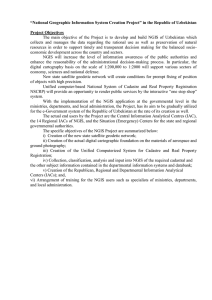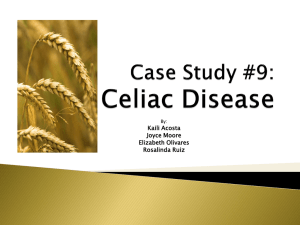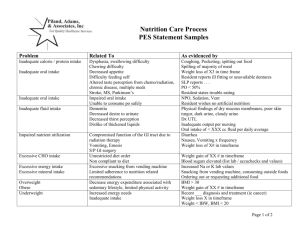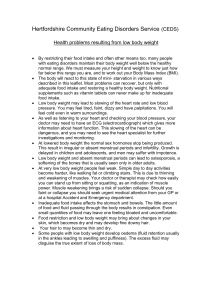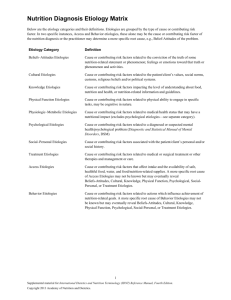Nutrition Diagnostic Terminology: IDNT Reference Guide
advertisement
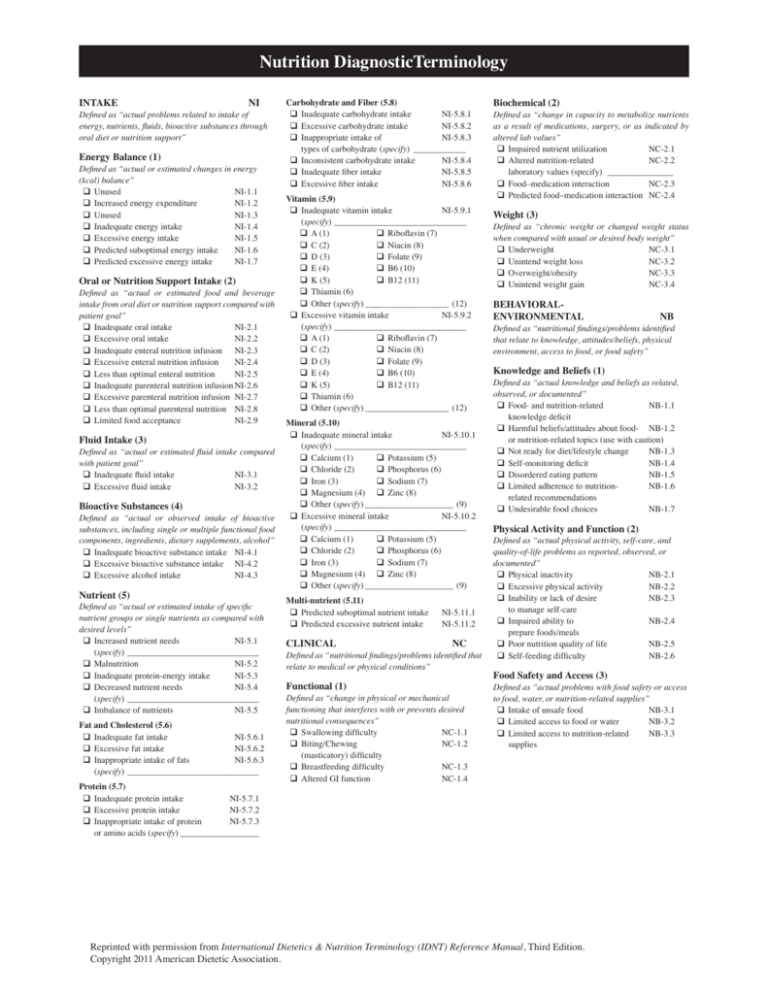
Nutrition DiagnosticTerminology INTAKE NI Defined as “actual problems related to intake of energy, nutrients, fluids, bioactive substances through oral diet or nutrition support” Energy Balance (1) Defined as “actual or estimated changes in energy (kcal) balance” Unused NI-1.1 Increased energy expenditure NI-1.2 Unused NI-1.3 Inadequate energy intake NI-1.4 Excessive energy intake NI-1.5 Predicted suboptimal energy intake NI-1.6 Predicted excessive energy intake NI-1.7 Oral or Nutrition Support Intake (2) Defined as “actual or estimated food and beverage intake from oral diet or nutrition support compared with patient goal” Inadequate oral intake NI-2.1 Excessive oral intake NI-2.2 Inadequate enteral nutrition infusion NI-2.3 Excessive enteral nutrition infusion NI-2.4 Less than optimal enteral nutrition NI-2.5 Inadequate parenteral nutrition infusionNI-2.6 Excessive parenteral nutrition infusion NI-2.7 Less than optimal parenteral nutrition NI-2.8 Limited food acceptance NI-2.9 Fluid Intake (3) Defined as “actual or estimated fluid intake compared with patient goal” Inadequate fluid intake NI-3.1 Excessive fluid intake NI-3.2 Bioactive Substances (4) Defined as “actual or observed intake of bioactive substances, including single or multiple functional food components, ingredients, dietary supplements, alcohol” Inadequate bioactive substance intake NI-4.1 Excessive bioactive substance intake NI-4.2 Excessive alcohol intake NI-4.3 Nutrient (5) Defined as “actual or estimated intake of specific nutrient groups or single nutrients as compared with desired levels” Increased nutrient needs NI-5.1 (specify)_______________________________ Malnutrition NI-5.2 Inadequate protein-energy intake NI-5.3 Decreased nutrient needs NI-5.4 (specify)_______________________________ Imbalance of nutrients NI-5.5 Fat and Cholesterol (5.6) Inadequate fat intake NI-5.6.1 Excessive fat intake NI-5.6.2 Inappropriate intake of fats NI-5.6.3 (specify)_______________________________ Protein (5.7) Inadequate protein intake NI-5.7.1 Excessive protein intake NI-5.7.2 Inappropriate intake of protein NI-5.7.3 or amino acids (specify)___________________ Carbohydrate and Fiber (5.8) Inadequate carbohydrate intake NI-5.8.1 Excessive carbohydrate intake NI-5.8.2 Inappropriate intake of NI-5.8.3 types of carbohydrate (specify)_ ____________ Inconsistent carbohydrate intake NI-5.8.4 Inadequate fiber intake NI-5.8.5 Excessive fiber intake NI-5.8.6 Vitamin (5.9) Inadequate vitamin intake NI-5.9.1 (specify)_______________________________ A (1) Riboflavin (7) C (2) Niacin (8) D (3) Folate (9) E (4) B6 (10) K (5) B12 (11) Thiamin (6) Other (specify)____________________ (12) Excessive vitamin intake NI-5.9.2 (specify)_______________________________ A (1) Riboflavin (7) C (2) Niacin (8) D (3) Folate (9) E (4) B6 (10) K (5) B12 (11) Thiamin (6) Other (specify)____________________ (12) Mineral (5.10) Inadequate mineral intake NI-5.10.1 (specify) _______________________________ Calcium (1) Potassium (5) Chloride (2) Phosphorus (6) Iron (3) Sodium (7) Magnesium (4) Zinc (8) Other (specify)_____________________ (9) Excessive mineral intake NI-5.10.2 (specify) _______________________________ Calcium (1) Potassium (5) Chloride (2) Phosphorus (6) Iron (3) Sodium (7) Magnesium (4) Zinc (8) Other (specify)_____________________ (9) Multi-nutrient (5.11) Predicted suboptimal nutrient intake Predicted excessive nutrient intake CLINICAL NI-5.11.1 NI-5.11.2 NC Defined as “nutritional findings/problems identified that relate to medical or physical conditions” Functional (1) Defined as “change in physical or mechanical functioning that interferes with or prevents desired nutritional consequences” Swallowing difficulty NC-1.1 Biting/Chewing NC-1.2 (masticatory) difficulty Breastfeeding difficulty NC-1.3 Altered GI function NC-1.4 Biochemical (2) Defined as “change in capacity to metabolize nutrients as a result of medications, surgery, or as indicated by altered lab values” Impaired nutrient utilization NC-2.1 Altered nutrition-related NC-2.2 laboratory values (specify) ________________ Food–medication interaction NC-2.3 Predicted food–medication interaction NC-2.4 Weight (3) Defined as “chronic weight or changed weight status when compared with usual or desired body weight” Underweight NC-3.1 Unintend weight loss NC-3.2 Overweight/obesity NC-3.3 Unintend weight gain NC-3.4 BEHAVIORALENVIRONMENTAL NB Defined as “nutritional findings/problems identified that relate to knowledge, attitudes/beliefs, physical environment, access to food, or food safety” Knowledge and Beliefs (1) Defined as “actual knowledge and beliefs as related, observed, or documented” Food- and nutrition-related NB-1.1 knowledge deficit Harmful beliefs/attitudes about food- NB-1.2 or nutrition-related topics (use with caution) Not ready for diet/lifestyle change NB-1.3 Self-monitoring deficit NB-1.4 Disordered eating pattern NB-1.5 Limited adherence to nutrition- NB-1.6 related recommendations Undesirable food choices NB-1.7 Physical Activity and Function (2) Defined as “actual physical activity, self-care, and quality-of-life problems as reported, observed, or documented” Physical inactivity NB-2.1 Excessive physical activity NB-2.2 Inability or lack of desire NB-2.3 to manage self-care Impaired ability to NB-2.4 prepare foods/meals Poor nutrition quality of life NB-2.5 Self-feeding difficulty NB-2.6 Food Safety and Access (3) Defined as “actual problems with food safety or access to food, water, or nutrition-related supplies” Intake of unsafe food NB-3.1 Limited access to food or water NB-3.2 Limited access to nutrition-related NB-3.3 supplies Reprinted with permission from International Dietetics & Nutrition Terminology (IDNT) Reference Manual, Third Edition. Copyright 2011 American Dietetic Association.

